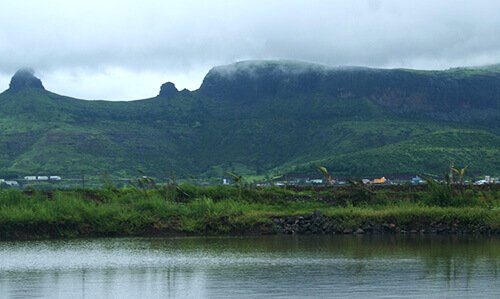Stagnant blood from the lower regions of the body, i.e. legs and abdomen is drained to the heart thereby improving the supply of fresh blood to these parts and the whole circulatory system. Blood supply to the head area i.e. brain, eyes, ears, nose and throat is improved thereby improving their functioning. Therefore all of the pelvic and abdominal area circulation, ear, throat and nose ailments are improved. The lung capacity is increased as the diaphragm, which is the muscle of respiration, has to work against gravity in this posture, this helps in the abdominal respiration and is therefore helpful in the treatment of asthma. Toxins in the respiratory system are drained thereby improving the respiratory system. Prevents and cures varicose veins. Detoxification of the body due to improved efficiency of the organs of the body which leads to youthfulness and anti-ageing effects. Due to the increased blood flow to the head the mind is tranquilized, stress and psychological disturbances are removed. The increased blood flow can be beneficial for those who suffer from headaches, though it should not be practiced at the time of headache. It releases the normal gravitational pressure from the anus muscles which helps with haemorrhoids. The nerves passing through the neck are toned and the neck flexibility is increased. The digestive system is greatly improved due to the increase in blood circulation and drainage of stagnant blood. The pranic flow is harmonized, increasing energy and having a positive effect on all the body systems. Balances the breath, ida and pingala. Balances the thyroid.Increases the circulation to the pituitary and pineal glands. Relieves constipation. Prevents atherosclerosis and restores vascular elasticity and tone. Beneficial for memory loss and dementia as well as increasing mental alertness. Increases the metabolism when held for longer periods of time, such as 10 - 15 minutes. Can be used as a mudra as written in Kriya, Kundalini and Tantric texts. Can be used instead of Sarvangasana, especially when one wants to put less stress on the neck.
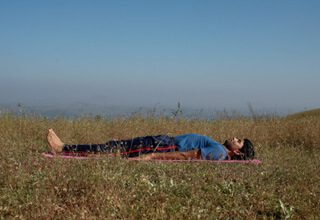
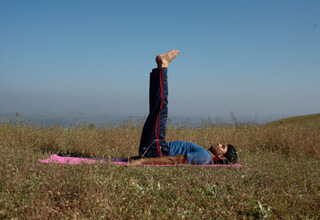
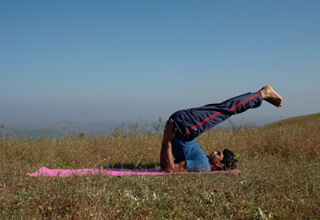
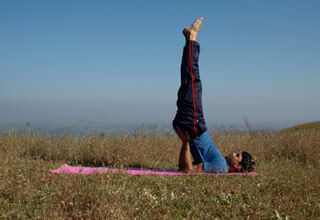
Beneficial for menstrual disorders.
Thyroid disorders. Asthma. Reproductive problems. Headache. Haemorrhoids. Varicose veins. Prevention of cough and colds. Diabetes. Memory loss and dementia. Atherosclerosis. Constipation. Obesity.
In supine position exhale and while inhaling slowly raise both the legs to a 90 degree angle from the floor. While exhaling raise the waist and the hips from the floor and take the legs backwards over the head. While inhaling place both hands below the waist for support and straighten the legs, toes pointing to the ceiling. The trunk of the body should be at a 45 degree angle from the floor. Gaze towards the toes and maintain the asana while breathing normally.
Inhale and while exhaling slowly lower the legs over the head, bring the arms back to the floor. Inhaling slowly lower the back to the floor, vertebrae by vertebrae, keeping the legs at a 90 degree angle from the floor. Exhaling slowly lower both legs back to the supine position. Relax and breathe normally.
Neck, shoulders, elbows, legs
On core area, throat
Keep the legs straight in knees with toes pointing to the sky. The trunk of the body should be kept about at a 45 degree angle from the ground. Head straight and eye sight fixed on the toes. Make sure that the trunk is raised enough vertically so that the chin can comfortably rest against the chest.
Bend the knees. Move the neck or overstrain. Bring the legs over the head when in the asana position but don't keep them completely vertical if it causes tension. Raise the head from the floor. Tense the legs or point the feet as this contracts the legs a.
Should not be performed by people suffering from high blood pressure, heart conditions or brain diseases. Should be avoided during menstruation and pregnancy. Should be avoided if suffering from an enlarged thyroid, spleen or liver as well as cervical spondylitis, slipped disc, headache and weak blood vessels in the eyes.
One may need a folded blanket under the neck, shoulders and elbows for support. For some beginners it may be difficult to raise the legs straight. If so then one can bend the knees a little while taking the position and then straighten out the legs. This asana will be different for everyone due to body proportions and individual differences in weight distribution. This position takes more abdominal strength than spinal muscle strength. It is a good position to practice coming in and out of if you want to develop more control over the abdominal muscles. For women it can be a more difficult pose to hold due to the greater proportion of weight in the lower body. It can also be more difficult for those with very flexible backs as the abdominal muscles have to work harder.
Dwi Pada Uttanpadasana.
Sarvangasana. Ashwini Mudra. Halasana. Vistrut Pada Halasana. Karnapeedanasana. Matsyasana. Chakrasana.
Supine
Phone - +91-9822770727
E-mail - yoga@yogapoint.com or yogapoint108@gmail.com
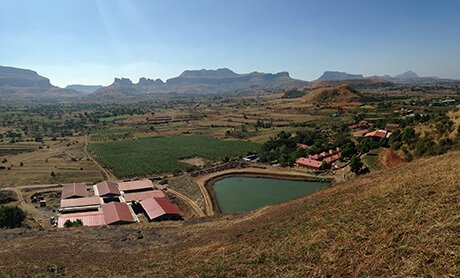
Yoga Vidya Dham, Kaivalya Nagari,
College Road, Nashik - 422005.
Maharashtra, India.
Phone - +91-9822770727 (for courses in ENGLISH)
+91-253-2318090 (For courses, in HINDI or MARATHI)
(Please call during 9.00 AM to 5 PM Indian Time)
E-mail - yoga@yogapoint.co or yogapoint108@gmail.com
Village Talwade, Trimbak, Nasik
Maharashtra,India.
Phone - +91-9822770727
E-mail - yoga@yogapoint.com or yogapoint108@gmail.com
